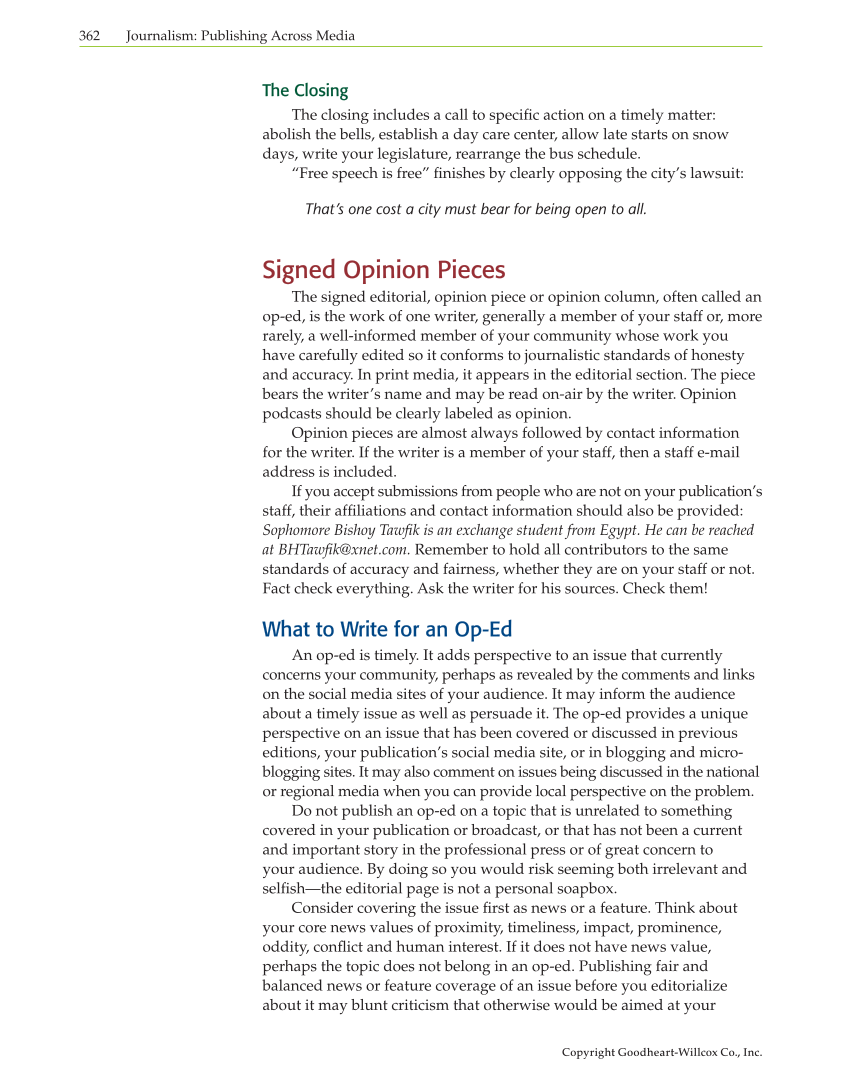Copyright Goodheart-Willcox Co., Inc. 362 Journalism: Publishing Across Media The Closing The closing includes a call to specifi c action on a timely matter: abolish the bells, establish a day care center, allow late starts on snow days, write your legislature, rearrange the bus schedule. “Free speech is free” fi nishes by clearly opposing the city’s lawsuit: That’s one cost a city must bear for being open to all. Signed Opinion Pieces The signed editorial, opinion piece or opinion column, often called an op-ed, is the work of one writer, generally a member of your staff or, more rarely, a well-informed member of your community whose work you have carefully edited so it conforms to journalistic standards of honesty and accuracy. In print media, it appears in the editorial section. The piece bears the writer’s name and may be read on-air by the writer. Opinion podcasts should be clearly labeled as opinion. Opinion pieces are almost always followed by contact information for the writer. If the writer is a member of your staff, then a staff e-mail address is included. If you accept submissions from people who are not on your publication’s staff, their affi liations and contact information should also be provided: Sophomore Bishoy Tawfi k is an exchange student from Egypt. He can be reached at BHTawfi k@xnet.com. Remember to hold all contributors to the same standards of accuracy and fairness, whether they are on your staff or not. Fact check everything. Ask the writer for his sources. Check them! What to Write for an Op-Ed An op-ed is timely. It adds perspective to an issue that currently concerns your community, perhaps as revealed by the comments and links on the social media sites of your audience. It may inform the audience about a timely issue as well as persuade it. The op-ed provides a unique perspective on an issue that has been covered or discussed in previous editions, your publication’s social media site, or in blogging and micro- blogging sites. It may also comment on issues being discussed in the national or regional media when you can provide local perspective on the problem. Do not publish an op-ed on a topic that is unrelated to something covered in your publication or broadcast, or that has not been a current and important story in the professional press or of great concern to your audience. By doing so you would risk seeming both irrelevant and selfi sh—the editorial page is not a personal soapbox. Consider covering the issue fi rst as news or a feature. Think about your core news values of proximity, timeliness, impact, prominence, oddity, confl ict and human interest. If it does not have news value, perhaps the topic does not belong in an op-ed. Publishing fair and balanced news or feature coverage of an issue before you editorialize about it may blunt criticism that otherwise would be aimed at your
